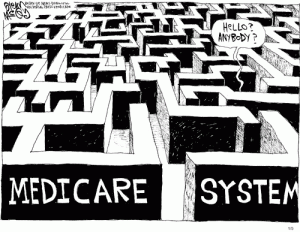By Jack Cumming
Does a nonprofit senior living enterprise offer consumer or business advantages over for-profits? That is a question that is seldom asked, though the answer is often taken for granted. If we give that question more thought, though, the commonsense answer may surprise you. The bankruptcy of Friendship Village in Schaumburg, Illinois, shows why and how.
The Nonprofit Myth
An estimate that 80% of senior living enterprises are “nonprofit” is frequently cited. How’s that working? One of the attributes of not-for-profit organizations is the limitation on financing opportunities. Most nonprofit CCRCs serve an affluent clientele and are financed by debt secured by entrance fees.
Technically, since entrance fees are required, they aren’t contributions, though many providers regard them as such. They are the initial contract consideration to seal the deal. Since entrance fees are often used as equity capital to secure corporate debt, they are at risk from the moment they are paid.
Deceptive Equity
The use of entrance fees as equity capital for nonprofits without a commensurate equity claim on ownership can be deceptive. The residents put up the “ownership” capital, but the sponsoring founders and managers exercise the ownership.
The theory is that nonprofits don’t distribute profits but reinvest them in the business. Many for-profits, too, of course, likewise don’t distribute profits per se. Amazon has never paid a dividend. Neither has Meta/Facebook or Alphabet/Google. That doesn’t make them tax-exempt.
A Satire in Three Acts
Most recently, Friendship Village at Schaumburg, said to be the largest CCRC in Illinois, has sought financial protection under Chapter XI of the Federal bankruptcy laws. Among other powers, a bankruptcy court can negate or revise contracts, a power that individual states do not have. Many times, that authority to rewrite contracts is why a prepackaged bankruptcy is sought.
Consider this from the consumers’ perspective. The consumer perspective for most nonprofit bankruptcies is a familiar satire in three acts. Is this what happened in Schaumberg? We don’t know.
First, they told us that a negative net asset position didn’t mean anything. Trust us. We need your entrance fees.
Then, they told us that finances were tight, but we’re working on a solution. Trust us. You’re safe with us.
Now, they tell us that we’re bankrupt, but it won’t last. Trust us. We’ve got everything under control.
End of satire. Start of reality.
Without a Parachute
CCRC residents have no protection like that insurance policyholders, bank depositors, pension recipients, and even stock brokerage customers have. In the absence of meaningful regulatory protections, residents are on their own, particularly with respect to the residual value of their entrance fee investments in lifelong continuing care.
In the meantime, Friendship Village at Schaumberg continues business as usual. It continues to solicit entrance fees despite bankruptcy. As of this writing, its website declares: “Most people take advantage of our value-packed Life Care contracts which guarantee them a home for life and provides priority access to, and guaranteed savings on quality health care services. The cost of a Life Care contract is divided into two parts: the one-time refundable entrance fee and the monthly service fee.”
It’s a bit unfair to the folks of Schaumburg to mention, but there’s an irony in the town’s name in light of what’s happening at Friendship Village. In German, Schaumburg means “foam fortress.” Most folks would prefer a Steinburg, a “stone fortress.” I’m sure that the residents of Friendship Village now wish they, too, had a better-fortified structure to protect them in their vulnerable latter years.
The Residents Plight
Residents might be presumed to be the principal stakeholders in a senior living enterprise. They are also the principal beneficiaries of the charitable purpose. Surprisingly, though, they are seldom represented in bankruptcy proceedings. Many bankruptcies, like the recent example of Air Force Village West, are prepackaged and streamlined through the court.
Residents have little voice in such proceedings. Occasionally, residents may find minority representation on the trade creditors committee. Almost never do the residents have their own committee or representation. They are fully at risk and often arguably victimized by the process.
Would the industry better serve its customers if it were predominantly taxpaying rather than nonprofit? Of course, there are some truly charitable enterprises serving the indigent. This question is for luxury CCRCs housing affluent people who show sufficient wealth as a condition for admittance.
For-Profit Advantages
A taxpaying enterprise can issue ownership shares to help rescue a community like Friendship Village at Schaumberg from causing resident disaster. A nonprofit “white knight” cannot. Moreover, a taxpaying enterprise can pay a fair price for what the entity has become and what its potential is, while a nonprofit may take over at book value.
And, perhaps most telling of all, a taxpaying enterprise can much more easily give residents an ownership stake in their “retirement” home. Who ever thought it was a good idea to entice consumers to sell homes they own to fund a home they don’t own and that may be at financial and managerial risk?
Back To The Myth
The myth is that consumers are better served by nonprofits. LeadingAge has made that a pillar of its advocacy. The belief is that nonprofit executives are more committed to service than profit, though CEOs of most nonprofit CCRCs are very well compensated. Whether an entity contributes taxes to the larger community or not, though, is not determinative of the caliber of those who lead the organization and who set its principles and mission.
Perhaps, the time has come for responsible industry leaders to seriously consider converting from nonprofits to mutually governed for-profits. Would today’s nonprofit CEOs change their character and values if the organization they lead became a taxpaying entity? Moreover, since residents have so much at stake in a nonprofit failure, shouldn’t they have more than a minimal say in any bankruptcy reorganization?










